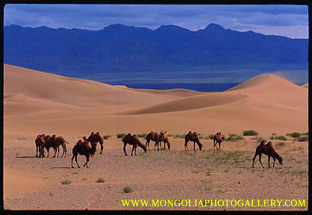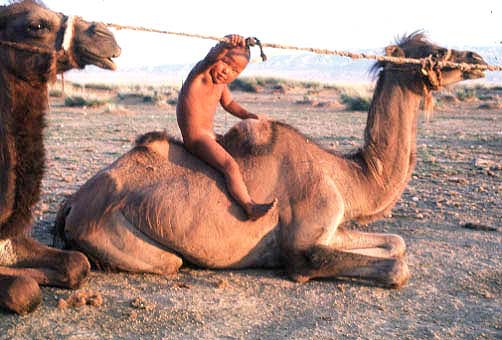 |
|  |
|
 |
 The wild two-humped Bactrian camel, camelus bactrianus ferus, is indigenous to Mongolia. It was domesticated at least three thousand years ago.
The camel is one of the tavunhorshoo,'five snouts,' the five domesticated animals of Mongolia on which the country's herding economy depends: horse, cow/yak, sheep, goat, and camel. Camels are raised all over Mongolia, but are found particularly in the four Gobi aimags (provinces) in the south.
As a means of transport, the camel has for centuries been vital for trade across the arid wastes of the country. The camel can carry at least 200 kilos of goods and walks at five kilometers per hour in its peculiar rolling gait. In other words, it is as fast as a packhorse, and has three times the carrying capacity. Unloaded, a camel can outrun a horse. In winter it continues to work through minus-twenty-degree temperatures. Because of the camel, the semi-deserts of the Gobi have not formed a barrier between Mongolia and the south. Even now, camels carry up to thirty percent of the cargo traffic in the Gobi. |

Watering camels in the Gobi is hard work. Most wells are draw-wells, not mechanically operated, and the water, often more than thirty feet deep, has to be raised by hand. As each camel drinks about 100-120 liters at a time (a horse drinks 40-50 liters), watering a herd can take several hours. A camel can go nine days without water, 33 days without food, though these are extremes which it is rarely forced to experience. A camel with two firm humps is in good health and has been recently fed and watered; if one or both of the humps droop, the camel needs some sustenance.
Besides its usefulness as a beast of burden, the camel gives five to eight kilos of wool per year, and up to 600 liters of milk a year. The milk is used for making hoormog, a kind of alcoholic tonic drink, as well as butter and different kinds of cheeses.
Camel meat is also valued, which has led to a precipitous fall in the number of camels in Mongolia in recent years. In 1994 the government placed a ban on killing camels -- herders were slaughtering their camels in lieu of smaller animals to fulfill the meat quotas, calculated by weight, that they must supply to cooperatives.
The Great Gobi Strictly Protected Area, 5.3 million hectares of protected land in the Southern Altai region, was created in 1975. It provides a final refuge for wild camels, the last surviving wild ancestors of the world's domestic camels. Perhaps 300 wild camels still remain in the Gobi, though there have been no recent surveys of this unusual animal, and the number is necessarily a rough estimate. |

|
Here we'll describe the photo above. |

|
|
|



